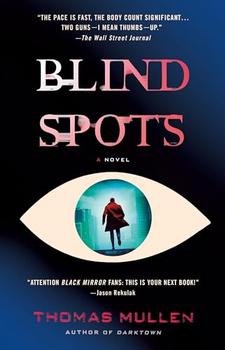Summary | Excerpt | Reviews | Beyond the Book | Read-Alikes | Genres & Themes | Author Bio

A Novel
by Thomas MullenThis article relates to Blind Spots
After a mysterious event that blinded the entire world population, the characters in Blind Spots use devices called vidders to see. In real life, many people are experiencing vision improvement through technology that might sound like something out of a science fiction novel. From smart glasses to implantable contact lenses, vision improvement technologies are proliferating for every need. Unfortunately, in the U.S., few of these options are covered by insurance and therefore are out of reach for many. (I have personally benefited from telling my doctor about my financial situation and having her advocate for me with the manufacturer of my own special lenses.)
The first eSight smart glasses were released in 2013, and the technology has been steadily improving since then. These glasses are good for people with central vision loss — those who are unable to see details in front of them well but retain side vision — including macular degeneration patients. Combining cameras, OLED technology and finely tuned software, the device transmits images to the user so they can see with an expanded field of vision. It is wireless so it can connect to Bluetooth and update automatically. Additionally, the eSight glasses can take pictures, connect to most televisions and serve as an e-reader. They come with 256 GB of storage, so photos and videos can be saved and accessed quickly. The manufacturer recommends them for users with 20/60 to 20/800 vision and "in some cases up to 20/1400." At the time of this writing, the latest model, the eSight 4, costs nearly $7,000 (with payment plans available).
Implantable contact lenses are another new treatment option for correcting vision. The implantation procedure is so simple it takes just 15 minutes and most patients are fully recovered by the next day. Made from Collamer (a combination of collagen and polymer), the lenses are inserted between a patient's iris and natural eye lens and conform to the shape of the eye. That flexibility means these lenses can be a good alternative for those who aren't candidates for LASIK because of pupil size, astigmatism or anything else that affects the eye shape. There are benefits to implantable contact lenses, but there are also risks; potential side effects include early cataracts and retinal detachment, and an improper fit may make glaucoma more likely for some patients.
Currently, this procedure is only recommended for those between 18-50 years old. Insurance companies consider it a cosmetic procedure and don't cover it. As of this writing, the contacts and their insertion could cost anywhere from $1,200-$5,000.
There are many ways to treat blindness caused by retinal disease, including prosthetic retinas and ultrasound wave treatments. Some research labs are exploring optogenetic options. In one kind of treatment, an Adeno-Associated Virus (AAV) targeting retinal cells is injected into the patient's eyes. The AAV virus is, researchers say, a "small, simple" one that induces retinal cells to make more photoreceptors that convert light into electrical signals, which our brains process into images. Researchers at the University of Pittsburgh School of Medicine developed this method, the first to restore vision with gene modification. Currently, this treatment is available under the name LUXTURNA and the price is steep at $850,000. However, the manufacturer has announced initiatives to get the consumer cost down. It certainly won't be the last gene-based eye therapy to hit the market.
Many researchers are also working on using stem cells to restore vision. Right now, there are unlicensed clinics offering stem cell eye treatment, so be careful to steer clear of those, or anyone offering treatment that's not FDA-approved.
Filed under Medicine, Science and Tech
![]() This "beyond the book article" relates to Blind Spots. It originally ran in May 2023 and has been updated for the
February 2024 paperback edition.
Go to magazine.
This "beyond the book article" relates to Blind Spots. It originally ran in May 2023 and has been updated for the
February 2024 paperback edition.
Go to magazine.
In order to become the master, the politician poses as the servant
Click Here to find out who said this, as well as discovering other famous literary quotes!
Your guide toexceptional books
BookBrowse seeks out and recommends the best in contemporary fiction and nonfiction—books that not only engage and entertain but also deepen our understanding of ourselves and the world around us.